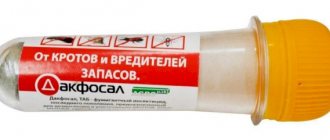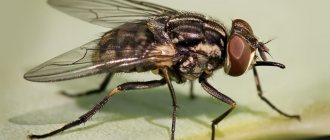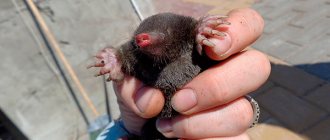Destruction of moles on the site
A mole is a small black (gray) animal that lacks eyes and ears. Its body length is no more than 20 cm. There are more than 40 species of animals. The mole mole is common in Russia. It digs passages underground, moving with the help of elongated front legs with claws. Nature compensated for the lack of vision in animals by developing their sense of smell and hearing. This allows them to sense prey from a distance. Mammals live from 2 to 5 years. Once a year (in spring) they give birth to cubs, of which there are about 5 in a litter. After 2 months, the offspring hunt on their own. Therefore, the fight against moles should be carried out immediately after they are discovered in the garden.
Harm from moles
Each mole has its own territory, the area of which is about 2 square kilometers. It eats protein foods: snails, beetles, and earthworms that are beneficial to the soil. In search of food, it digs up the soil at a depth of 25 cm - 35 cm, where plant roots are located. They are damaged and the plant dies. The mole even gnaws the roots of bushes and trees. The animal digs up to 50 m of tunnels per day. Heaps of earth form on lawns. They cause lawn equipment to break down. Sometimes communication connections (wires, sewer structures) deteriorate. Holes dug by moles become roads for small rodents: shrews, rats, mice.
Due to their anatomical features, animals slowly move along the ground by crawling. This makes them vulnerable to foxes, large birds. In winter, to avoid predators and frost, moles nest in the roots of large trees at a depth of 2 meters.
The appearance of animals is evidenced by dug pyramidal piles of earth. Over time they will cover the entire garden. Moles will not voluntarily leave the area until it is completely depleted. Therefore, if pests are detected, immediately call specialists from the sanitary and epidemiological station. Fighting moles is their specialty.
Biological characteristics
The mole family (Talpidae) belongs to the order of insectivores of the mammalian class. In Russia there are 4 species from the genus of common moles (Talpa) and 2 from the genus Mogera. The appearance of moles is widely known : they have a small, round and elongated body (up to 23 cm long), covered with thick, short, velvety fur of a dark gray or black color; a shortened neck with an elongated head and a small tail (up to 4 cm long); Forepaws turned outward with powerful claws and spade-shaped palms. Small and blind eyes are hidden under the skin above the muzzle with a movable nose-proboscis. There are no external auricles. The number and structure of teeth, depending on the genus of moles, varies from 33 to 44 units. The weight of adult animals is about 170 grams.
Females give birth to 3-9 cubs, which are born blind and naked
In the first half of May, the female hatches from 3 to 9 naked, helpless, but fast-growing cubs, bearing them for 40 days. 6 weeks after birth, the babies leave the nest for underground passages, and at two months of age they are ready for independent life. The lifespan of the animals is about 4 years.
Habitat and lifestyle features
Moles prefer soft, loose, moist, but not swampy soil. Therefore, for a full life, they find fertile places rich in insects. They are not interested in peat or sandy areas.
The purpose of the network of feeding tunnels dug by the mole is that various insects and earthworms fall into them, becoming easy prey. The animal regularly checks the fullness of the passages, and if they are empty, then digs new ones.
Earthworms and insects that fall into mole tunnels become prey for the animal
Moles make their nests from dry branches and leaves or moss underground at a depth of up to 1.5 m, usually placing them in the center of an dug network of feeding tunnels. In summer, feeding passages located at a depth of up to 15 cm from the ground surface are used for hunting; before winter, they break into the lower layer of the earth. In them, animals make chambers, so-called pantries, for storing supplies. To quench their thirst, the animals dig deep vertical passages or lead them to streams and ponds.
The total length of the passages is about 6 m per 1 m2 of area, and the speed of movement of the animals, for example in black soil, reaches 108 meters per hour.
The pest throws excess soil to the surface, and as a result, heaps of earth appear throughout the area where it has settled, which are called “molehills.”
A characteristic sign of the appearance of pests on the site are earthen mounds - mole hills
Having a separate system of passages, animals most often stay isolated from their relatives, with the exception of the mating season. When meeting other individuals in their feeding area, they show aggression. Due to their underground lifestyle, they have practically no natural enemies , except that in rare cases, when they get out, they can become a victim of a fox or owl.
Special glands that secrete a musky odor allow them to attract insects and worms, and their upright growing hair helps them move along narrow earthen passages in any direction.
Animals make their nest in the center of their feeding tunnel system.
A mole can eat an amount of food equal to its own weight in a day , and hunger for seventeen hours leads to its death. Accelerated metabolism and maintaining a constant body temperature force animals to spend a lot of time looking for food, taking short breaks to sleep. 5 hours after satiation, they are ready for a new meal, and between feedings they fall into a sleepy state.
Gluttony is directly related to the replenishment of energy expended on active movements underground by these warm-blooded animals.
In spring and summer, animals include earthworms, beetles and their larvae, and other insects in their diet, and can also attack frogs, lizards and young small rodents . In winter, when the number of insects and their larvae is reduced, the main dish remains worms stored for the winter.
The mole leaves immobilized worms in his tunnels as winter reserves.
The mole paralyzes the worm by biting through the nerve ganglion; as a result, the worm remains lying in the feeding canal. With the help of such reserves, animals spend the winter. In addition, mice and shrews often get into mole passages, which also serve as food for the small predator.
Signs of moles
The voracious animals love moist, soft soils. The best habitat is loosened and watered soil. In the area it likes, the pest digs tunnels underground, harming the plants. Makes food warehouses and beds.
Moles are difficult to spot in soft soils. Mounds that are pushed outwards are formed when they dig holes in solid ground. The soft soil around the perimeter of the hole is compacted. And the gardeners have no idea that they were visited by uninvited guests. Signs of moles:
- Damaged root vegetables.
- Death of plants with regular watering and care.
- Reduction of earthworms in the area (can be seen after rains).
- Infrequent earthen piles in places where the soil is less cultivated and not watered.
An effective way to combat moles can be found if you find out the scale of infestation of the territory. If fruit trees or garden plants are grown on it, the procedure should be entrusted to professionals. They will help to avoid deterioration of the ecological situation on the site, which often happens when mammals are killed independently.
Prevention
Given the characteristics of moles, it is much more difficult to get rid of them than from rodents or other pests, so it is recommended to follow preventive measures that can help prevent the likelihood of their appearance on the site:
- Installation of a fairly rigid and solid fence along the boundaries of the entire site; the material can be used linoleum , roofing felt, slate or ordinary metal mesh, which will need to be folded in several layers. The fence is buried in the ground, the height above the ground surface should be at least 50 cm, then the result will be a barrier that underground inhabitants will not be able to overcome.
- Planting onion plants and legumes on the site.
- Organization of ditches along the perimeter of the site, which are filled with gravel, crushed stone and coarse sand; these layers can be covered with ordinary soil on top. However, it is worth noting that if a mole is attracted to something on the site, then such a barrier will only delay it, but will not be able to stop it.
Stages of SES operation
To combat moles, contact the sanitary and epidemiological station:
- Fill out an application on the website or contact us by phone.
- Specialists will take the order to work. Only they know how to get the mole out quickly.
- On a day agreed upon with the customer, professionals will inspect the area and select the best methods and means.
- Instruct the client about precautions.
- They will conclude a contract for the work.
- They will exterminate moles in your summer cottage (garden), after which there will be no pests left.
Should you rely on folk remedies?
The effectiveness of many traditional methods has not been confirmed. Some of them are aimed at destroying moles. They are advised to gas them, kill them with shovels, or feed them food with poison. By exterminating animals, summer residents can affect their numbers and even provoke a decrease in the population in certain regions.
The corpses of animals that die from poisoning remain underground and emit an unpleasant odor. The poison from them gradually penetrates into the soil. This has a negative impact on plants: they may die or begin to accumulate toxic substances. Fruits grown in such areas are dangerous to eat.
Practice shows that many humane methods do not get rid of moles. If animals disappear, it doesn’t last long. After a few days or weeks, they return to their inhabited territories.
100% guarantee of results from “Yastreb”
The Yastreb company creates vibroseismic repellers. They produce low-frequency sounds and vibration waves that diverge in all directions from the device and are reflected from obstacles. If there are buildings with foundations in the center of the site, it is better to install several repellent devices. Signals may not penetrate dense walls.
The combined action of “Hawk” is aimed at creating in moles the feeling of an approaching predator that they are afraid of. The animals will try to stay away from the sound source.
The company provides a 1 year warranty on its devices. If underground animals appear on the site again, you should check whether the batteries on the device are discharged.
Vibroseismic mole repeller.
Methods for exterminating pests
When choosing a method for exterminating moles, you should pay attention to such factors as the degree of infestation of the garden and the presence of pets. Ways to fight moles:
- Biological. Cats and hunting dogs help destroy the family of animals. The technique works with a small number of underground inhabitants.
- Mechanical. Digging barriers (slate) along the edges of the garden, netting under the lawn, glass in holes. However, barriers along the edges of the site are a preventive measure; if pests have already settled there, it will not help. An effective method of fighting moles in the garden is traps that are installed on both sides of the hole, but first you need to find the tunnel where the mole lives.
- The trade has several pesticides designed to kill pests. Gardeners place poisoned baits near minks. Such methods of fighting moles are dangerous because the poisoned pest can be eaten by a pet. Proper use of pesticides allows you to quickly combat moles. However, over time, animals become insensitive to them or stop eating baits.
Humane methods of extermination include repellents. Electrical analogues made in the form of a tape are effective. When animals come into contact with it, they receive a weak discharge of electricity. After this they leave the inhabited territory. Natural repellents are milkweed and marigolds.
Electronic repellers
Hardware stores offer devices of varying power and, accordingly, operating area. Such equipment creates special vibrations that spread along the ground. The distance over which the action of repellent devices extends depends on the characteristics of the product of a particular manufacturer.
Often, owners of personal plots have to buy several electronic devices. The devices are installed at the very beginning of spring and are not dismantled until the end of the summer season.
Experienced users note that it is better not to install such devices in areas where cultivated plants are planted. This is due to the fact that at the very beginning of use, pests will show increased interest in the foreign structure. As a result, the number of soil mounds will increase, threatening the potential harvest.
About a month after installing electronic repellers, animals will gradually move to a distance of 10 meters or more from sources of unpleasant vibrations. Then the mammals will completely leave the area.
Acoustic equipment
Devices "Mole", "Mole" and other products can be purchased in specialized stores for gardeners and vegetable gardeners. The operating principle of such devices:
- the equipment creates ultrasonic waves that are similar to danger signals;
- moles cease to navigate in space.
The main advantage of this method is its safety. But an acoustic device is not enough for even the smallest garden plot. In addition, ultrasound creates discomfort for people and pets (cats, dogs, rabbits, etc.). The effect of using the device does not last long. If you turn it off, the moles will return and cause trouble again.
How professionals work
Fighting moles
Animals can concentrate at depth or on the surface of the earth. Only professionals know how to remove a mole. They use certified methods and tools. The price for deratization will be lower than purchasing questionable pesticides in a store, since specialists provide a guarantee on their work.
At the initial stage (when there are few potholes) of infection, traps are placed around the perimeter of the garden.
In case of moderate damage (except for old ones, there are new potholes), mole traps are placed, and professional pesticides are laid out around the perimeter of the garden.
In case of mass infestation of animals (death of plants, damage to tree roots, a large number of potholes, mounds), experts use gas extermination of moles and other methods in combination:
- Insecticide is injected into mole holes using hot (cold) fog. Pests rush to the surface through exits.
- Traps with bait containing an attractant are installed near the burrows, into which animals disturbed by the fog fall. Moles that were deep in burrows and were not exposed to fog are attracted by attractants and fall into traps.
- Every meter (along the perimeter of the garden) to a depth of 35 - 40 cm, repellers with odors that moles cannot tolerate are dug in in a checkerboard pattern. Therefore, animals from the neighboring area will not be able to enter.
Poisons and improvised means
Industrial enterprises produce chemical compounds that help get rid of moles. Many modern products meet safety requirements and cause almost no harm to the soil and plantings. However, care must be taken when using. Poisons can enter the body of an adult, child or pet and lead to irreversible consequences.
Under no circumstances should you try to create poison at home. Rat poison, as well as poisonous powders that quickly dissolve in water, will not work. After rain, chemicals will penetrate into the fertile layers of the soil.
A good solution would be to contact companies specializing in pest extermination. You will have to pay more for the services of professionals than for drugs in a store, but the effectiveness of this method is much higher.
Repellent home solutions
Summer residents often use castor oil. Mix 200 ml of castor oil and a few tablespoons of liquid soap. You can use dishwashing detergent. 15 ml of the resulting composition are dissolved in 2 liters of water. The solution is sprayed evenly over the entire treated area. It is better if the ground is damp. For this reason, it is recommended to carry out the procedure after watering or rain.
Other home remedies with strong odors will also help. You need to soak cloth or paper in them, and then put them in molehills. You should sprinkle some soil on top. For this purpose the following are used:
- petrol;
- kerosene;
- ammonia;
- valerian;
- naphthalene.
Shovel
This is the most important weapon of a summer resident, which is always nearby. Moles are eliminated from the site and remain alive, i.e. this is the most humane way. After rain, you need to trample down the raised molehills. The animal will definitely return and begin to restore them.
During the recovery process, the ground will begin to rise again. It is worth allowing the animal to restore a few meters of passages, and then begin to trample the soil sharply. The mole will return and begin to rebuild the tunnels again. It is important to seize the moment correctly, plunge the shovel deep into the ground and quickly remove the pest along with the soil layer. The mole should be placed in a deep container and taken to the forest. There it will eat insects and worms, so it will not harm the garden.
Hollow tubes
You can take a reed or reed trunk, as well as light pipes with a small diameter and a length of at least 2 m. The device is stuck into the hole. 50-60 cm of pipe should remain on the surface. In strong winds, air masses passing inside will create a hum. The hum scares off the moles, and they leave the area.
Destruction by gassing
An effective way is to fight moles using fumigators. They act upon the evaporation of steam and gases. Only specialists wearing protective clothing work with these toxic substances. They fumigate their burrows using a hot fog generator. The equipment heats the pesticide to the state of steam. They fumigate earthen labyrinths.
Fumigators come in tablets. They fit into holes, the exits are closed. The tablets release poisonous gas when they are exposed to moisture from the soil.
Killing moles with gas has undeniable advantages:
- Speed of work.
- Extermination of moles in the entire garden.
- The poison is not deposited in the ground.
- Does not pose a danger to insects.
Destruction of moles on the site: prices
| Area up to 10 acres | From 6500 rub. |
| From 10 to 30 acres | From 9500 rub. |
| From 30 to 50 acres | From 13500 rub. |
| From 50 to 80 acres | From 16,000 rub. |
| From 80 to 100 acres | Negotiable |
Methods for independent control of moles
Today there are a large number of ways to destroy moles . Let's first look at amateur methods of fighting moles. It should be understood that not all of these methods have proven effectiveness, but the correct use of these methods will still get rid of moles in the garden.
Firecrackers
Moles are afraid of sharp loud sounds. Let's find out how to destroy a mole in the garden using firecrackers:
- Buy several low-power firecrackers.
- Find mole holes in the area.
- Wear boots with hard, thick soles.
- Light the firecracker and throw it into the mole pit. After this, cover the hole with your foot so that all the noise from the explosion of the firecracker goes underground.
- Gardeners claim that with the help of such “shock therapy” you can get rid of harmful animals for a long time.
Alarm
You can also create loud noises that scare away moles using cans and alarm clocks. Let's find out how to destroy a mole in the garden using an alarm clock:
- First you need to buy some simple little alarm clocks that ring loudly. If the area is not too large, then 2 alarm clocks will be enough to scare away moles.
- Now set one alarm for the morning and another for the night.
- Place the alarm clock in a large three-liter jar and close it with a lid.
- Bury the jars with alarm clocks to a depth of 40-60 centimeters.
- Moles will be frightened by vibration and noise, so they will have to leave your area.
Electricity
Let's find out how to destroy a mole on your property using electricity:
- Buy several electric repellers from the store.
- Bury them in the ground on your site. You need to bury repellers in different corners of the site so that the repellers cover a larger area.
- If a mole steps on such a repeller, it will receive a painful electric shock.
- Typically, electric repellers are low-powered, so they are not capable of killing the animal, but the painful experience will force the mole to leave your area.
Water
Let's find out how to destroy a mole on your property yourself using water:
- Find a mole hole on your property.
- Attach a hose to the tap water faucet.
- Place the other end of the hose in the mole hole.
- Turn on the water at full power for 3-4 minutes. Water, having penetrated underground, will flood all passages and holes, which will force the mole to leave your area.
- You can repeat this procedure several times for preventive purposes, but the frequency of this procedure should be no more than 2 sessions per day.
- It should also be remembered that flooding mole holes with water cannot be done if the mole lives next to any buildings. Otherwise, water may erode the foundation, which can lead to the collapse of the building.
Ratchets
Now let's look at an example of how to destroy moles using a ratchet:
- To make a ratchet, you will need a regular plastic bottle with a cap and an old non-working electrode.
- Make a hole in the bottle and in the cap for a day, and then insert an electrode into these holes.
- Take scissors and cut out some blades from the bottle.
- Dig a ratchet 10-20 centimeters into the ground.
- The ratchet is ready. The principle of its operation is as follows: during wind, the bottle will rotate around its axis. This will cause the bottle to vibrate, and the vibrations will be transmitted through the electrode into the ground, which can seriously anger the moles, causing them to have to leave the area.
- If necessary, you can make several ratchets to install them in an area away from each other.
Traps
destroy a mole on the site using traps:
- Solomon's trap. Take a small metal or wooden cylinder, the diameter of which is 30-40 centimeters. Attach special doors to the edges of the cylinder that can only open in one direction. After this, bury the trap in the ground at a depth of 15-30 centimeters. The mole will be able to enter Solomon's trap, but not get out. After a while, check the trap and get rid of the caught mole.
- Using a three-liter jar or small bucket. Dig a special hole in the ground where the mole has an underground passage. The depth of the hole must exceed the size of the bucket or jar so that the container can completely fit into it. After this, place a bucket or jar in the hole, put a few earthworms in there for bait, and then cover the container with a thin, opaque sheet of plywood. After this, also cover the hole with another sheet of plywood to prevent light from entering the hole. A mole, having stepped on plywood, will fall into a jar or bucket, but it will not be able to get out of this container.
Advantages of working with a sanitary and epidemiological station
We employ qualified personnel with medical education. Modern equipment and professional preparations for mole control in the garden that we use are safe for people. We work at the agreed price, we do not change it. We carry out all procedures in accordance with SanPin standards.
We work daily and around the clock. Call. Write.
Additional Information:
- Extermination of rats
- Destruction of mice
- Destruction of shrews
Damage or benefit? What function do moles perform to a greater extent?
For moles, garden plots and summer cottages are the most tempting lands. They are not particularly attracted to ordinary sandy lands. And on dacha soils there are many living creatures for them, which they are not averse to feeding on.
Why do all summer residents and gardeners want to get rid of these pests? What harm do they cause?
- Harm plants, particularly roots.
- They eat earthworms that recycle the soil.
- They bring to the surface a low-fertility substrate that negatively affects the soil.
- They lay “paths” for other pests (rats and mice).
- The roots of trees are undermined (as a result of which the tree dies).
If you find moles on your summer cottage, they will not stop only on your plot, they will go further to the neighboring ones.
Moles not only cause harm to your land, but also have a positive effect on the soil:
- By laying “tunnels” underground, they loosen the soil, thereby saturating it with oxygen, which will give your crops rapid growth.
- “Tunnels” increase the nitrogen content in the soil.
- They eat all larvae and other underground inhabitants that harm the soil.
Pests prefer to build their “homes” under the sun. About 20 houses can be “built” on one site.
Important point! Moles cause irreparable damage to the crop, so all land holders are ready to make every effort to overcome the “pests”.











